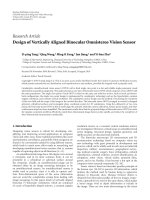Researching UX user research great design begins with deep empathy
Bạn đang xem bản rút gọn của tài liệu. Xem và tải ngay bản đầy đủ của tài liệu tại đây (7.64 MB, 203 trang )
ASPECTS
OF
UX
THE KEY TO SUCCESSFUL DIGITAL PROJECTS
You’re beginning a user research project. You want it to go well.
You want it to be interesting, to learn something new and to
generate ideas. Most importantly, you want your project to make
a difference. This book will show you how to achieve all of that.
YOUR AUTHOR
James has worked in research for 20
years, for organizations including
Google, British Airways, the BBC,
eBay and the Alzheimer’s Society.
He is currently Head of Research at
cxpartners.
EMMA
HOWELL
• Discover how to choose the right research methodology for your project
Emma Howell is a User Experience
Consultant at cxpartners. She has
been a research specialist for 10
years, beginning her career in
academia before moving into UX.
Emma loves designing products
and services that are intuitive and
enjoyable to use.
• Get smart interviewing tips to help you obtain the data you need
• Learn how to analyze your data and present results
SITEPOINT BOOKS
WEB DESIGN
PRINT ISBN: 978-0-9953826-3-3
Advocate best practice techniques
Lead you through practical examples
Provide working code for your website
Make learning easy and fun
USD $34.95
LANG &
HOWELL
Visit us on the Web at sitepoint.com or for sales and support email
CAD $46.95
RESEARCHING UX: USER RESEACH
Design research can sometimes seem a daunting, confusing
world unto itself. With its own codes and jargon, it can feel like
the domain of specialists, forbidden to outsiders who haven’t
been trained in the rules. If you’ve ever felt out of your depth on
a research project, been unsure what to do next, or wondered
whether you’re “doing it wrong”, then this book is for you.
UX
JAMES
LANG
This book is about the craft, the technique and the processes
involved in running a design research project. Research is at the
heart of user-centered design. Because it’s so central, we believe
that research should be an activity that the whole team gets to
participate in and feel ownership of.
• Recruit people to take part in your research
RESEARCHING UX
USER
RESEARCH
BY JAMES LANG
& EMMA HOWELL
GREAT DESIGN BEGINS WITH DEEP EMPATHY
Safety Area: All Text, Logos & Barcode should remain inside the Pink Dotted Lines
Bleed Area: All Backgrounds should extend to, but not past, the Blue Dotted Lines
i
Researching UX: User Research
by James Lang and Emma Howell
Copyright © 2017 SitePoint Pty. Ltd.
Product Manager: Simon Mackie
Series Editor: Joe Leech
English Editor: Katie Monk
Technical Editor: Kate Towsey
Cover Designer: Alex Walker
Illustrator: Natalia Balska
Notice of Rights
All rights reserved. No part of this book may be reproduced, stored in a retrieval system or
transmitted in any form or by any means, without the prior written permission of the
publisher, except in the case of brief quotations embodied in critical articles or reviews.
Notice of Liability
The author and publisher have made every effort to ensure the accuracy of the information
herein. However, the information contained in this book is sold without warranty, either
express or implied. Neither the authors and SitePoint Pty. Ltd., nor its dealers or
distributors will be held liable for any damages to be caused either directly or indirectly by
the instructions contained in this book, or by the software or hardware products described
herein.
Trademark Notice
Rather than indicating every occurrence of a trademarked name as such, this book uses the
names only in an editorial fashion and to the benefit of the trademark owner with no
intention of infringement of the trademark.
Published by SitePoint Pty. Ltd.
48 Cambridge Street Collingwood
VIC Australia 3066
Web: www.sitepoint.com
Email:
ISBN 978-0-9953826-3-3 (print)
ISBN 978-0-9953827-9-4 (ebook)
Printed and bound in the United States of America
ii Researching UX: User Research
About James Lang
James has worked in research for 20 years, for organizations including Google,
British Airways, the BBC, eBay and the Alzheimer’s Society. He is currently Head
of Research at cxpartners.
About Emma Howell
Emma Howell is a User Experience Consultant at cxpartners. She has been a
research specialist for 10 years, beginning her career in academia before moving
into UX. Emma loves designing products and services that are intuitive and
enjoyable to use.
About SitePoint
SitePoint specializes in publishing fun, practical, and easy-to-understand content
for web professionals. Visit to access our blogs, books,
newsletters, articles, and community forums. You’ll find a stack of information on
JavaScript, PHP, Ruby, mobile development, design, and more.
iii
James: To my mum and dad, Sally and Joseph, for giving me their curiosity,
patience and kindness.
Emma: For raising an analytical and inquisitive creature, my fabulous parents
Pauline and Leigh. My gyaldem: twerking and tequila makes deadlines feel less
painful. Laura-Lea: you’ve been amazingly encouraging and patient. Thank you.
iv Researching UX: User Research
Table of Contents
Preface ............................................................................. xiii
If You Feel Unsure, Then Read On ...........................................................xiii
What We’ll Cover in this Book .................................................................xiv
The Gist of the Book ................................................................................... xv
Acknowledgments ....................................................................................xviii
Conventions Used ....................................................................................xviii
Supplementary Materials..........................................................................xix
Chapter 1
Begin the Project .....................................1
Get Started ..................................................................................................... 2
1. Define Your Research .................................................................... 3
2. Define Hypotheses......................................................................... 3
3. Timeline & Resources .................................................................... 4
4. Engage Stakeholders ..................................................................... 4
5. Identify Risks .................................................................................. 5
Tools You Can Use ......................................................................................... 5
Use Desk Research to Generate Hypotheses ................................. 5
Hold a Kickoff Workshop ................................................................. 6
Table of Contents v
Talk to Your Stakeholders ................................................................. 9
Create a Research Canvas...............................................................10
Project Plan .......................................................................................12
Make a Plan to Engage People ......................................................13
4. Decide How You Will Communicate With Your Team ..........15
Work Through Risks to the Project ...............................................16
Summary.......................................................................................................18
Chapter 2
Choose an Approach ..........................20
The Core Concepts ......................................................................................21
What is Data? ...................................................................................21
Qualitative vs. Quantitative ...........................................................22
Discovery vs. Validation ..................................................................23
Insight, Evidence and Ideas ............................................................23
Validity ...............................................................................................24
Scaling Your Investment.................................................................26
Multi-Method Approaches.............................................................26
In-The-Moment Research ..............................................................27
Taking Care .......................................................................................28
Research as a Team Sport ...............................................................29
Research Methods .......................................................................................29
vi Researching UX: User Research
How to Choose Research Methods ..........................................................34
How Many People? ..........................................................................35
Summary.......................................................................................................36
Chapter 3
Finding Participants ...........................37
Who To Recruit ............................................................................................38
Defining Your Sample .....................................................................39
Creating a Recruitment Brief ........................................................41
Getting The Right People ...........................................................................44
Creating a Screener .........................................................................45
Methods of Accessing People ...................................................................49
1. Recruitment Agencies.................................................................49
2. Guerrilla Recruitment .................................................................51
Finding Participants for Guerrilla Testing ...................................51
3. DIY Recruitment ..........................................................................52
4. Gatekeepers ..................................................................................53
Persuading People to Take Part ................................................................54
Why Offer an Incentive? ................................................................54
Offering an Appropriate Incentive ...............................................55
Arranging Sessions ......................................................................................56
Running Order ..................................................................................56
Table of Contents vii
Avoiding No-shows .........................................................................57
Data Protection ...........................................................................................58
Informed Consent ............................................................................58
Summary.......................................................................................................60
Chapter 4
Writing a Discussion Guide ............61
What’s the Discussion Guide For? ............................................................62
What’s a Discussion Guide Not For? .............................................62
Elements of a Discussion Guide ................................................................63
Different Kinds of Session ..............................................................71
Questions, Tasks, and Activities ................................................................71
Types of Content ..............................................................................73
How to Write a Discussion Guide .............................................................77
Use Your Imagination .....................................................................78
Summary.......................................................................................................79
Chapter 5
Set Up Your Sessions ..........................80
Getting Prepared for Research in the Lab ..............................................81
Monday: Three Days Before Your Session ...................................82
Tuesday: Two Days before your session .......................................84
Wednesday: The Day Before Your Session ...................................87
viii Researching UX: User Research
Thursday: The Day of Your Session ...............................................90
Getting Prepared for Research in the Field ............................................91
Tuesday: Two Days Before Your Session ......................................84
Wednesday: The Day Before Your Session ...................................87
Thursday: The Day of Your Session ...............................................90
Getting Prepared For Remote Research ..................................................94
Monday: Three Days Before Your Session ...................................82
Tuesday: Two Days Before Your Session ......................................84
Wednesday: The Day Before Your Session ...................................87
Thursday: The Day of Your Session ...............................................97
Summary.......................................................................................................97
Chapter 6
Running Your Sessions......................98
Roles ..............................................................................................................99
The Interviewer ................................................................................99
The Host.............................................................................................99
Note-taker ..................................................................................... 102
Taking Notes ............................................................................................. 103
Post-It Notes .................................................................................. 103
Taking Notes in a Spreadsheet or Trello ................................... 105
Taking Typed or Written Notes ................................................... 106
Table of Contents ix
Taking Notes in Guerrilla/Field Research .................................. 108
Taking Notes after the Interview ............................................... 109
Tools For Recording ................................................................................. 109
Top Tips For Recording Your Sessions......................................... 111
The Practicalities of Using Different Devices .......................................113
Remote Testing When Using Different Devices ........................114
Guerrilla Testing With Different Devices ...................................114
Summary.....................................................................................................114
Chapter 7
Interviewing ..........................................115
Show Participants How to Help You ......................................................116
Observing vs. Asking .................................................................................118
Paying Deep Attention .............................................................................118
Starting the Session..................................................................................119
Make Sure You Get Consent ....................................................... 120
Starting Guerrilla Testing Sessions ............................................ 121
How to Ask a Question............................................................................ 121
How To Get Out Of Trouble .................................................................... 127
Summary.................................................................................................... 129
Chapter 8
Analyzing Your Data ........................130
x Researching UX: User Research
Why Bother? ............................................................................................. 131
Phases of Analysis .................................................................................... 132
Cherry-picking Analysis Activities......................................................... 132
How Much Time Do I Need? ................................................................... 136
Phase 1: Make a Plan .............................................................................. 137
Activities ......................................................................................... 137
Phase 2: Absorb the Data ....................................................................... 139
Create a Space ............................................................................... 139
Collate Sources .............................................................................. 141
Reformat ........................................................................................ 141
Rejecting Bad Data ....................................................................... 141
Prioritize ......................................................................................... 142
Review Recordings ........................................................................ 143
Transcribe ....................................................................................... 143
What to Watch Out For ............................................................... 144
Phase 3: Finding Patterns ....................................................................... 145
Review Objectives or Rolling Hypotheses................................. 145
Brain Dump .................................................................................... 146
Who Were the People? ................................................................. 146
Conceptual Diagrams ................................................................... 148
Maps & Sketches ........................................................................... 149
Table of Contents xi
Tablecloth ....................................................................................... 150
Affinity Sort ................................................................................... 150
What to Watch Out For ............................................................... 153
Phase 4: Working With Patterns ........................................................... 153
Thought Experiments ................................................................... 154
Extension ........................................................................................ 155
Think By Making ........................................................................... 155
Metaphor........................................................................................ 155
What to Watch Out For ............................................................... 156
Phase 5: Creating a Narrative ................................................................ 156
Analysis as a Team Sport......................................................................... 158
Summary.................................................................................................... 159
Chapter 9
Turning Research Into Action .....160
Making Your Research Relevant ............................................................ 161
Engaging Stakeholders Throughout the Project ................................. 161
Attending Research Sessions ...................................................... 161
Show and Tell (AKA Pizza Sessions) ........................................... 162
Topline Findings ............................................................................ 163
Project Blog / Websites ................................................................ 163
Documenting What You’ve Learned ..................................................... 164
xii Researching UX: User Research
Report Deck ................................................................................... 168
List Reporting ................................................................................ 170
Journey Map .................................................................................. 170
Experience Map ............................................................................. 172
Personas .......................................................................................... 174
Showreel ......................................................................................... 177
Debrief Session ......................................................................................... 178
Summary.................................................................................................... 182
Preface xiii
Preface
I was on stage at UX Manchester and I made a flippant comment about how all
focus groups were a waste of time when it came to researching the user
experience. When questions came at the end of my talk, a hand shot up. “I don’t
agree with your comment about focus groups. They have their uses. All research
methods have their strengths and weaknesses.” That hand belonged to James
Lang. He came and found me afterwards and we debated the merits of user
research methods. At the end of the conversation, I asked if he was looking for a
job.
Emma brings 10 years of formal research experience in psychology, cognition,
medicine, biology and, of course, user experience. Emma and James are two of
the best researchers I’ve ever worked with. I’ve learned so much from working
with them on many UX research projects over the years.
This book represents Emma and James’s many years of research experience. Their
practical advice on how to run an insightful, successful research project is the
key to making your digital products even better.
Series editor Joe Leech (@mrjoe) Bristol, UK, October 2017. PS. I was right about
focus groups – see Chapter 2.
If You Feel Unsure, Then Read On
You’re beginning a user research project. You want it to go well. You want it to be
interesting, to learn something new and to generate ideas. Most importantly, you
want your project to make a difference. This book will show you how to achieve
all of that.
This book is about the craft, the technique and the processes involved in running
a design research project. Whether you’re in discovery or evaluation mode,
whether your project is agile or waterfall, research is at the heart of user-centered
design. Because it’s so central, we believe that research should be an activity that
the whole team gets to participate in and feel ownership of.
xiv Researching UX: User Research
At the same time, design research can sometimes seem a daunting, confusing
world unto itself. With its own codes and jargon, it can feel like the domain of
specialists, forbidden to outsiders who haven’t been trained in the rules. If you’ve
ever felt out of your depth on a research project, been unsure what to do next, or
wondered whether you’re “doing it wrong”, then this book is for you.
What We’ll Cover in this Book
Over the next nine chapters, we’ll pass through the stages of a qualitative design
research project. The primary focus is on the practicalities: our intention is to
share a step-by-step guide so you know what do to at each point… especially if
you’re stuck! Alongside that, though, we’ve provided a rationale, not least
because being able to understand and justify your approach is pretty useful in
itself.
The structure of the book follows the sequence of a research project:
0-1. The research cycle
Design
Chapter 1 shows how to scope and kick off your project, involving stakeholders
to ensure you’re working to the right objectives.
Chapter 2 walks through the process of choosing a methodology, and the different
considerations which play a part in your decision.
Setup
Chapter 3 covers the different methods for recruiting people to take part in your
research, and how to ensure you get the right participants.
Preface xv
Chapter 4 outlines the role of a discussion guide (aka session plan, aka script) and
shows you how to piece it together part-by part.
Chapter 5 looks at the runup to your research sessions, and the preparation
involved with lab-based, remote and contextual studies.
Fieldwork
Chapter 6 shows you how to manage a research session, and how to be successful
in the roles of observer, note-taker or moderator.
Chapter 7 focuses on the detail of interviewing, exploring the anatomy of
questions and the role of observation.
Analysis
Chapter 8 lays out a system of analysis, describing each of the main phases and
showing you which activities to deploy to achieve your specific purpose.
Impact
Chapter 9 shows how to bring the project to a successful conclusion, using
deliverables and engagement techniques to maximise the impact of your work.
Unless you’re completely new to research, you’re probably more familiar with
some of these aspects of the process than others. You should be able to dip into
the book as required, rather than reading from front to back, with a couple of
exceptions:
If you want to know how to run research sessions, it’s a good idea to look at
Chapters 4, 6 and 7.
If you’re interested in how to ensure your projects have maximum impact, the
information you need is in both Chapter 1 and Chapter 9.
The Gist of the Book
As we’ve already mentioned, this book is more interested in the practicalities of
research than the theory. That said, if you read on you’ll see several ideas surface
repeatedly. Let’s introduce them:
xvi Researching UX: User Research
Research is a team sport. We believe research projects are most effective when
the whole team’s involved, not when one or two specialists are tasked with going
away to ‘do research’ and come back with an answer. Working as a team - sharing
the hypothesising, interviewing and analysis - brings the designers, developers,
content owners and others much closer to the actual user experience, rather than
having it fed back to them via a report or presentation. It’s a better, more
rewarding experience for everyone, but more importantly it makes the research
more likely to have an impact. You may not always be able to get the whole team
involved throughout, but we’ll share the workarounds you can use to achieve
nearly the same result.
When you’re making decisions about your project, think about the end point and
work backwards. Whether it’s to generate new ideas, build empathy for users,
understand a problem better, or inform decision-making, your project has an end
goal. In most cases, this’ll be a combination of overt, stated objectives and more
obscure aims that you’ll have to figure out from talking to stakeholders. Don’t lose
sight of the end goal, because it should inform your decisions at every point. For
example, if your end point is to build empathy with users among disengaged
stakeholders, then that will inform your choice of methodology and sample, the
types of data you collect, and the approach you use to analyse and report it. It’ll
also determine the way you involve stakeholders throughout the project. We’ll
show you why you need to stay aware of those choices and consciously direct
your approach with the end goal in mind, rather than just hoping for the best.
Successful research is about driving design decisions through engagement, not
delivering documents. To be most effective, research projects are about enabling
the people who make decisions about things to experience the lives of the people
who use those things. If you can give stakeholders an in-person connection with
their users, you'll enhance and enrich their work, and they'll thank you for it.
You'll also help them make better decisions more easily, and therefore do better
work, and they'll love you for that. Good and easy decisions don't often come
from reading research reports, often because there's no human experience
connected with the recommendations and they're therefore not followed. Also,
it's easy to put a report away and ignore it, especially if it doesn't fit that person’s
agenda. But when a stakeholder has seen users first-hand as they comment on or
do something, recommendations are much more likely to be implemented. We’ll
show you how to get stakeholders engaged, and keep them engaged, using
Preface xvii
deliverables as the final call to action.
Do as much research as you need to, and then stop. You need to be able to justify
the time you spend on research: there’s no point in large-scale research projects
that deliver no outcome. Instead, we’d argue for sequences of bite-sized projects,
taking a slightly different focus and methodology each time. Moving in this way,
and accruing insight as you go, allows you to find out just what you need and no
more, leaving your time and budget free to act on what you’ve found. Erika Hall
calls this ‘just enough research’, and we think it’s a great way of balancing out the
risk of ill-informed decisions against the cost of further projects. We’ll share some
planning tools you can use to structure your project, and decide when enough’s
enough.
Analysis starts at the beginning. As you begin a research project, you’ll already
have ideas, hunches and preconceptions about the subject you’re investigating.
Instead of trying to ignore them, you should get them out in the open.
Confusingly, research projects have a distinct ‘analysis stage’, but in practice
analysis is something that you do throughout the project, by taking your initial
impressions and then challenging and evolving them through talking to and
observing users (a process that Roddy Glen calls ‘rolling hypotheses’). Ultimately,
the purpose of research is to make better decisions. The process of engaging with
users is purely to arrive at better informed, more substantiated, more inspired
decisions. We’ll show you rigorous, practical tools you can use to turn your
initial thoughts into findings and recommendations at the end of the project.
Research is about consent. User-centered design is based on the belief that by
understanding and delivering what users need, you can achieve better outcomes
for your organisation. To do this, you need empathy and respect: going beyond a
superficial understanding of people as consumers, or users, or customers, and
engaging with them deeply as real, rounded people with needs, motivations,
emotions and desires. Think of your research as a collaboration between your
team, as designers, and the people who use your product or service. If you’re
conscious of the reasons why they might (or might not) want to take part, the
ways that the research experience might affect them, their preconceptions and
concerns, then you’re not just being a good person, you’re being a good designer
too. We’ll walk you through the steps you should take to engage with participants
and their data with respect and care.
xviii Researching UX: User Research
Enough theory. It’s time to start your project.
Acknowledgments
Many people helped us to write this book. The editorial team at SitePoint, Joe
Leech and Simon Mackie, expertly guided the project with a blend of
encouragement and critique. Our technical editor, Kate Towsey, offered an
inspiring alternative perspective and challenged our missteps.
Particular thanks to the colleagues at cxpartners who read and responded to early
drafts: Mark Skinner, James Chudley, Angelique Alexander, Mina Bach and
Audun Clark. We were lucky to have input from other experts in the field too:
Kristy Blazio at Usability One, Roddy Glen (formerly of Strategic Research
Group), Barbara Langar (formerly of eBay, now at Insight Angels), Gemma Newell
at the BBC, and David Whittle at Spotify. Finally, the people who laid the
foundations: Romin Tafarodi, Alison Lyon and Pete Comley.
Conventions Used
You’ll notice that we’ve used certain typographic and layout styles throughout
this book to signify different types of information. Look out for the following
items.
Tips, Notes, and Warnings
Hey, You!
Tips provide helpful little pointers.
Ahem, Excuse Me ...
Notes are useful asides that are related—but not critical—to the topic at hand.
Think of them as extra tidbits of information.
Preface xix
Make Sure You Always ...
... pay attention to these important points.
Watch Out!
Warnings highlight any gotchas that are likely to trip you up along the way.
Supplementary Materials
are SitePoint’s forums, for help on
any tricky web problems.
is our email address, should you need to contact us to
report a problem, or for any other reason.
1 Researching UX: User Research
1
Chapter
Begin the Project
Starting a research project can feel manic. There’s lots to organise: briefs to write,
objectives to agree, and stakeholders to bring on board. It’s easy to feel like you’re
being swept away on a sea of madness. But with a bit of organisation, it doesn’t
have to be overwhelming. If you get the setup right, the rest of the process will be
less stressful and more productive.
In this chapter, we’ll show you:
How to start off a project effectively.
What to expect at each stage of the project.
How to ensure your project generates action at the end.
Begin the Project 2
Get Started
To make sure you’re making a good start, it’s helpful to refer to the checklist
below, and tick off the things you need. It’s also a good way to structure your
activities.
1-2. The research cycle: design phase
You need…
How to create it
How to record it…
Research
objectives
Kickoff workshop or written
brief (overt objectives)
Project canvas
Stakeholder interviews (covert
objectives)
Hypotheses
Desk research
Discussion guide
Stakeholder interviews
Timelines and Post-it planning
resources
Roles & responsibilities
Project plan
RASCI
Communication plan
Stakeholder
buy-in
Stakeholder interviews
Engagement plan swimlanes
within project plan
Risks
Pre-mortem
Risk register
3 Researching UX: User Research
1. Define Your Research
You will probably already know there’s a need for research, but at this stage it
might be quite vague. It’s your job to get clarity about the research objectives,
otherwise your work will be unfocused, and less likely to achieve anything
useful.
With your colleagues, you need to define your objectives. These fall into two
categories:
Business objectives are the end goal of the project. An example business
objective: increase conversion rate by 5%.
Research objectives are the learning goals of the project. An example research
objective: understand how customers buy shoes for their children.
You should also expect some objectives to be more obvious than others: ‘overt
objectives’ are the ones talked about openly, while ‘covert objectives’ are kept
quiet (but are no less important). For your project to be considered a success,
you’ll need to take into account both the overt and covert objectives.
Your objectives are the single most important element in your project. As you
proceed, you’ll continually return to them: to help choose the right methodology,
to shape your questions, to check you’re on track, and to inform your analysis.
2. Define Hypotheses
When you define objectives, you’re laying out the questions you want to answer.
When you define hypotheses, you’re making your best initial guess at what those
answers will be. The rest of the project – asking users and conducting analysis –
is the process of checking, challenging and refining your initial answers until
you’ve reached solid conclusions.
We use two kinds of hypothesis in our research projects:
Formal hypotheses are statements which can be tested against the data to
determine if they’re supported or not. For example: “Regular shoe-store
customers own more pairs of shoes than occasional shoe-store customers.”
This kind of hypothesis is used in quantitative research, and if you’ve
Begin the Project 4
conducted experiments at university, you’ll probably be familiar with it.
Rolling hypotheses are early-stage theories or explanations that evolve
throughout the project. Think of them as hunches or assumptions, which you
can evolve, add to or reject by observing and talking to users. Rolling
hypotheses start off vague, and become more solid as you proceed. This kind
of hypothesis is used in qualitative research, but is very similar to the process
of learning more about any subject you previously knew little about.
When you start a project, it’s helpful to get all of the team’s assumptions
(hypotheses) out in the open, so you can incorporate them into your questioning.
3. Timeline & Resources
In most research projects, time is of the essence. Generally, you’ll be working
towards a deadline, or in a fixed cycle of sprints, and you’ll need to shape your
approach accordingly. Also, you’ll have finite resources to work with.
Defining the right approach in terms of timelines and resources – and ensuring
you’re able to stick to it – is one of the main skills of running research projects.
You may be lucky enough to have a dedicated project manager, but if not, you’ll
be in charge of putting together the plan, and reviewing progress each day to
check you’re on track.
4. Engage Stakeholders
If you want your research to have an impact, you’ll need to make sure your
colleagues are engaged in the process. To do that, you need to be communicating
and collaborating throughout the project, not just at the end. The earlier you get
started, the more stakeholders will care about your results, and want to own and
act on them. Therefore, you need to plan.
The trick to successful communication is to think of it as an ongoing sequence,
rather than one-off messages. Think strategically and plan it as a campaign,
running from the beginning of the project and on past the final documentation.
We’ll show you how to do this later in the chapter.
5 Researching UX: User Research
5. Identify Risks
All projects have risks: things that might go wrong. It’s important to face up to
these possibilities and plan for them, rather than just hope for the best.
Otherwise, you may find you get caught out, and the project runs over time or
budget, or threatens to under-deliver.
Risks emerge throughout the project, but nonetheless you should have a pretty
clear idea at the beginning what might happen, based on the team’s collective
past experience. If you deal with these possibilities openly, you can agree on an
appropriate response (which might be to take no action at all!). Either way,
tackling risks is a decision for the whole team, not one you should have to take
on your own.
Tools You Can Use
Now that we’ve described the building blocks you need to get started, it’s time to
look at the tools you can use to create them.
Use Desk Research to Generate Hypotheses
Desk research sounds dull, but it’s actually a great way to get your head into a
subject right at the beginning. If you approach it creatively, you can use many
different approaches – see below.









